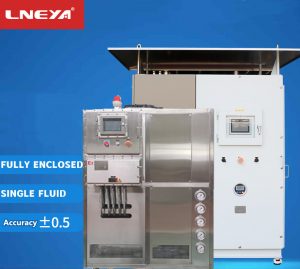산업용 냉각기 시스템은 어떻게 작동합니까?
When using industrial machinery, a cooling system may be required to prevent the machine from overheating. Refrigeration equipment can effectively keep materials in the optimal temperature range, but how does the chiller work? Understanding the working principle of industrial water chiller is very helpful to select the best refrigeration system to meet the needs of users.

Working principle of industrial water chiller
In short, industrial water chillers cool process fluids. Process fluid (usually water or water / glycol mixture) is used to cool machinery, equipment, etc. The process fluid absorbs heat from the cooled object and then passes through the chiller, where the heat is removed from the fluid and transferred to the ambient air.
Refrigeration circuit
The industrial water or glycol chiller system consists of two main circuits: refrigeration circuit and fluid circuit. The refrigeration circuit consists of four parts: compressor, condenser, expansion valve and evaporator. The refrigeration circuit removes heat from the process fluid. The fluid circuit usually consists of fluid reservoir, pump, filter and heat exchanger. The fluid circuit carries process fluid around the cooled object.
Refrigeration cycle steps:
Refrigeration circuit is the most technical part of the working mode of chiller. The refrigeration cycle uses the principle of thermodynamics to effectively transfer heat from one region to another. In the case of a chiller, heat is extracted from the cooled fluid and transferred to the ambient air.
압축기
The refrigeration cycle starts with the compressor. The compressor uses gaseous low-pressure and low-temperature refrigerant to compress it into high-pressure and high-temperature gas.
콘덴서
The gas then flows through the coils in the condenser. In the condenser, air or water will flow through the coil and remove heat from the refrigerant. As the refrigerant loses heat, it will begin to condense until all the gases condense into a liquid.
확장 밸브
After leaving the condenser, the liquid passes through the expansion valve. The expansion valve limits the flow of refrigerant. When the high-pressure liquid passes through the expansion valve, it enters the evaporator.
증발기
The evaporator is where the refrigerant begins to evaporate. When the refrigerant evaporates, it becomes very cold and absorbs a lot of heat. The process fluid will interact with the cold refrigerant in the evaporator. Heat is removed from the fluid and transferred to the refrigerant. The refrigerant then enters the compressor and the cycle begins again.
관련 권장 사항
-
화학 및 제약 생산 공정에서 온도 제어가 필요한 반응에는 어떤 것이 있나요?
1020정밀한 온도 제어는 화학 및 제약 제품 생산에서 합성/결정화 중 반응 공정에서 중요한 역할을 합니다. 정밀 화학 분야에서는 많은 화학 반응 공정과 결정화 공정이 ...
세부 정보 보기 -
Use and maintenance of laboratory/bioengineering temperature control system
9761. Read the equipment manual carefully before use, get familiar with the operation process and key instructions, and operate in strict accordance with the conditions specified in the manual. 2. When moving the laboratory/bioengineering temperatur...
세부 정보 보기 -
초저온 냉동고 구매 팁
1174산업용 냉장 처리에 관해서는 초저온 냉동고가 필수 불가결합니다. 그것에 대해 말씀 드리겠습니다! 무석 관야 냉동 기술 유한 회사의 초저온 냉동고는 주로 산업용 냉동고에 사용됩니다 ...
세부 정보 보기 -
LNEYA 격리 방폭형 냉각 가열 순환 시스템 SR-35N
677LNEYA 격리 방폭 냉난방 순환 시스템은 주로 난방용 열전달 매체와 냉방용 냉매를 사용합니다. 그렇다면 격리 냉온수 순환 시스템의 주요 액세서리는 무엇입니까? 어떤 효과가 ...
세부 정보 보기
 LNEYA 산업용 냉각기 제조업체 공급 업체
LNEYA 산업용 냉각기 제조업체 공급 업체











